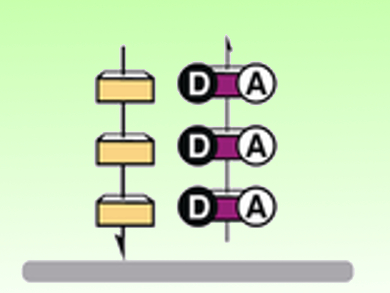Organic solar cells have received considerable attention as low-cost alternatives to conventional solar cells. Still, the quest to find materials that enable organic solar cells to reach or even surpass the energy conversion efficiencies of their inorganic counterparts is ongoing. Recently, dipolar push-pull chromophores have been utilized for the production of highly efficient organic solar cells. However, to achieve high optoelectronic performance, the chromophores need to be highly ordered, which has been the major limitation for further applications of the material.
Stefan Matile, University of Geneva, Switzerland, and colleagues have synthesized perfectly aligned two-channel dipolar photosystems. The systems are composed of electron-transporting central naphthalenediimides (NDIs, pictured yellow) and two different hole-transporting aminoperylenemonoimides (APIs, pictured purple). These push-pull components form ordered π stacks (pictured).
Depending on the molecular orientation of the APIs, the overall dipole moment of the structures can either point outward or inward, whereas a combination of both leads to an antiparallel mixed structure. The ordered photosystems are overall more photoactive than the antiparallel one.
- Dipolar Photosystems: Engineering Oriented Push-Pull Components into Double- and Triple-Channel Surface Architectures,
Altan Bolag, Naomi Sakai, Stefan Matile,
Chem. Eur. J. 2016, 22, 9006–9014.
DOI: 10.1002/chem.201600213



